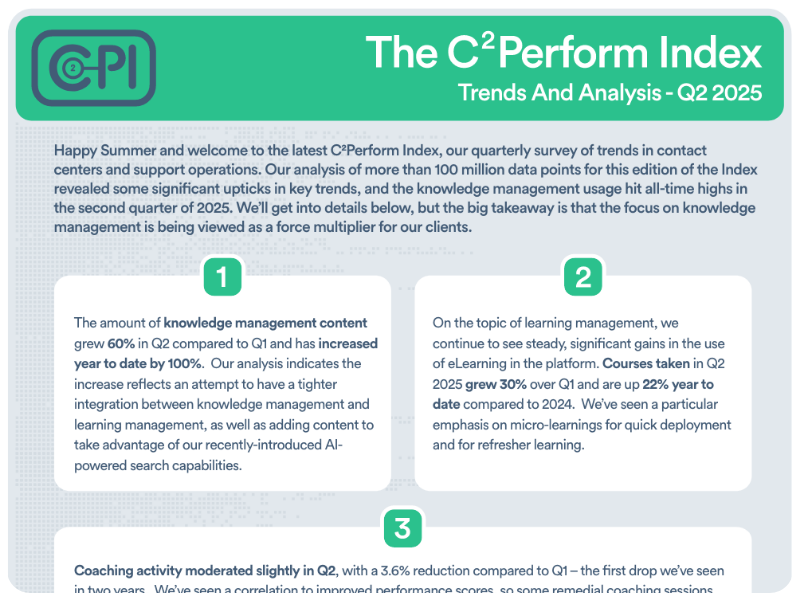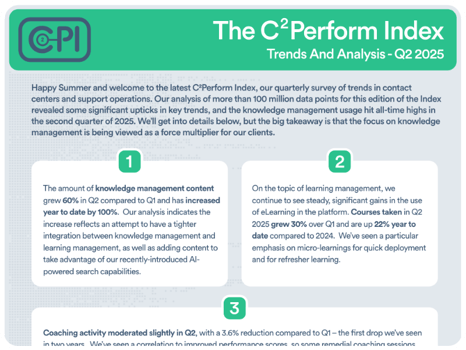In any organization, being able to maximize the performance of your employees is important. Unfortunately, not every organization is able to make steady progress on driving employee engagement and performance.
How important is continuous improvement? Enhancing employee performance on an individual level can have a direct impact on the organization’s ability to meet its performance goals and service level agreements (SLAs).
The trick is knowing how to drive employee performance. One method is to focus on employee engagement. Gallup notes a strong correlation between employee engagement and performance—stating that “highly engaged teams outperform the rest in 11 business outcomes” following a survey of over 100,000 business units/teams.
Another method is to focus on coaching employees to help them identify their strengths and weaknesses—then find ways to maximize their strengths while shoring up their weaknesses.
What Is Employee Coaching?
Odds are that you’re already familiar with coaching as a general concept. The Society for Human Resource Management (SHRM) defines coaching in business environments as “a training method in which a more experienced or skilled individual provides an employee with advice and guidance intended to help develop the individual’s skills, performance, and career.”
The SHRM definition seems to assume that the one doing the coaching is another employee—usually a high performer identified by the leadership team. However, this falls more in line with mentorship.
In many organizations, the task of coaching falls to the manager of the team or even to someone whose primary job is providing coaching. Sometimes, this means that the person providing the coaching isn’t someone who has extensive experience in doing the same job as the person being coached—which can create some friction in the coaching process.
When conducting coaching, it’s important to follow a few best practices and tips to ensure that the coaching session is as effective as possible. But, is coaching worth the effort?
3 Benefits of Employee Coaching
One of the potential challenges of getting buy-in to launching a coaching initiative in your organization is demonstrating whether coaching sessions will have an impact. Over the years, many different organizations have realized numerous benefits from coaching their employees, such as:
1. Helping Employees Find Purpose within the Organization
This benefit sounds esoteric, but it can have a significant impact on employee engagement, retention, and performance. Helping an employee find a purpose—some reason behind why they should do what they do—can have a powerful effect on their motivation.
Employees who are stuck in a grind and never see the purpose behind their work are not very likely to put in the extra effort to generate results. They’ll keep doing the bare minimum to avoid losing their job and that’s it.
Coaching sessions give managers an opportunity to communicate directly with employees and share with them the purpose behind their work. This can be accomplished by reviewing the results associated with the employee’s work. The results reviewed don’t have to be limited to meeting the employee’s results KPIs, either.
For example, managers could discuss a sale completed because of research the employee provided to a sales team member, a customer who met their own goals because they provided extra support or a positive review generated because of an action they took. Any of these kinds of events can serve as the purpose of an employee’s work.
2. Increased Employee Performance
One of the most obvious benefits of coaching sessions is that they can help to improve employee performance. By sitting down with an employee to review their performance and provide advice for improving it, coaching sessions can be instrumental for helping employees be better at what they do.
This can be done by reinforcing an employee’s strengths, shoring up their weaknesses, or doing both. For example, say that Sam is a sales rep working in a call center who has to cold call prospects repeatedly and try to sell them on the company’s new product. However, he struggles to meet his weekly goal for new deals closed.
When reviewing Sam’s call performance data, his manager notices that Sam spends a few minutes less on each call compared to all of his teammates who are meeting their goals. The manager could then, during the coaching session, review that information and ask Sam why he stops calls earlier than his peers. Depending on Sam’s answer, the manager could recommend a few different changes to how Sam handles calls. Some examples of responses could include:
- Because I Ran Through the Whole Call Script. In this case, the manager might recommend a few different ways to modify the sales call script so Sam can engage with prospects for a bit longer.
- Because I Wasn’t Getting a Response. Here, the manager could actually recommend that Sam switch to a new call even faster since time spent not getting a reply could be keeping Sam from reaching prospects who are more willing to talk.
- Because the Prospect Hung Up. Prospects hanging up (especially on cold calls) is extremely common for call center employees. Here, the manager could walk Sam through strategies for generating customer interest and keeping prospects on the line long enough to make progress.
3. It Helps Identify Consistent Issues with the Team
When conducting a coaching session, managers often get invaluable feedback from employees that they might not be comfortable sharing in front of a group of their peers during a regular team meeting.
By taking notes of which issues seem to be common for the employees they coach, managers can identify pervasive issues that may be negatively impacting employee engagement, retention, and productivity. Knowing that there’s a problem is the first step in solving issues that impact employee performance.
As a leader, it’s important to identify obstacles and remove them so your team can realize its maximum potential.
How to Coach Employees
So, how can you ensure that your coaching sessions have the maximum impact? It helps to know when to coach employees, how to start a coaching session with an employee, which of them need the most coaching, and what questions to ask when coaching an employee.
Here are a few simple tips to get you started:
- Review Employee Strengths and Weaknesses Before the Coaching Session. Before the coaching session begins, you should have a solid idea of what the employee is doing well and where they need to improve. This way, you can spend more time helping the employee learn to improve rather than flipping through performance reports trying to find key data points to review.
- Provide Positive Feedback on Employee Achievements/Strengths. Recognition is an important element in employee engagement. Yet all too often, one-on-one sessions with employees devolve into simple performance reviews that pick at the worker’s weaknesses and how they can improve without providing adequate recognition for a job well done. Starting the session by providing kudos to an employee for a major achievement or milestone can help set a positive tone and make the employee more receptive to the feedback provided during the rest of the coaching session.
- Use Active Listening Skills. Coaching sessions aren’t just a one-way interaction. As Harvard Business Review puts it, “managers tend to think they’re coaching when they’re actually just telling their employees what to do.” This authoritarian approach to coaching doesn’t engage employees. Instead, it frustrates them and stunts their development within your organization. Practice using active listening skills during coaching sessions to gather feedback from the employee. This helps make the employee feel more appreciated and can uncover potential issues that may be affecting employee performance.
- Take the Employee’s Experience Level into Account. Not every employee can be a veteran with a decade’s worth of experience at their job. A new hire who you recruited fresh out of college likely won’t be as proficient as the person who has been at the job for the last fifteen years. For example, Biz Library defines five different levels of proficiency for employees: Novices, Doers, Performers, Masters, and Experts. Novices shouldn’t be expected to perform to the standards of a Master or Expert—but they should be guided to grow into those skill levels over time.
- Learn What Motivates Your Employees. What is it that makes your employees want to work? While salary is the most obvious motivation, it’s far from the only one. Using your active listening skills to uncover what it is that your employees want to do or get out of their work can be crucial for establishing a purpose to their work that motivates them to new personal heights. For example, does the employee enjoy getting positive feedback from clients/customers? Or, do they prefer to have opportunities to grow beyond their current role? Not every employee seeks a promotion to a new spot or a bigger paycheck—though most wouldn’t deny either if offered, it wouldn’t necessarily have much impact on their motivation. By identifying what actually motivates them, you can provide employees with the right “carrot” to keep them engaged with their work and performing at their best.
- Keep the Coaching Session Organized by Creating a Form for It. While there will always be a need to customize the actual contents of a coaching session based on the needs and feedback of the employee being coached, it can help to have a designated form with notes on major topics you wanted to discuss with the employee. This can help you keep the coaching session a bit more structured and “on task” with whatever results you wanted to see from the meeting.
Employee Coaching Form Example
What kind of information should your employee coaching form have? Here’s a basic outline of elements to use when creating your custom template for coaching sessions:
- Employee Information (name, employee ID #, job title/position, etc.)
- Manager/Coach information (name, ID #, etc.)
- Current Date (for documentation purposes)
- Recent Employee Results Data (a list of key performance metrics for the employee relevant to the coaching session)
- Items to Discuss (a list of items that should be covered during the coaching session, such as any major achievements or areas for improvement)
- Desired Outcome (what is it that you want to achieve—increased engagement, fixing a performance issue, collecting feedback, or something else?)
- Benefits of Change (how will achieving the desired outcome help the employee and/or the organization?)
- Actions Need to Improve Performance (this can be filled in during the session, and will call for specific actions to take to help the employee meet or exceed performance goals)
- Employee and Manager Signature Lines (to establish that the employee received the feedback and understood what was expected of them)
|
Employee Name
|
Manager/Coach Name
|
|
Employee Job Title
|
Date
|
|
Employee Results Data
|
|
Items to Discuss
|
|
Desired Outcome
|
|
Benefits of Change
|
|
Actions Required
|
|
Employee Signature
|
Manager/Coach Signature
|
Need help engaging employees and improving their performance? Reach out to C2Perform today to get started!
 English
English Español
Español





.png?height=350&name=Untitled%20(300%20x%20175%20px).png)



